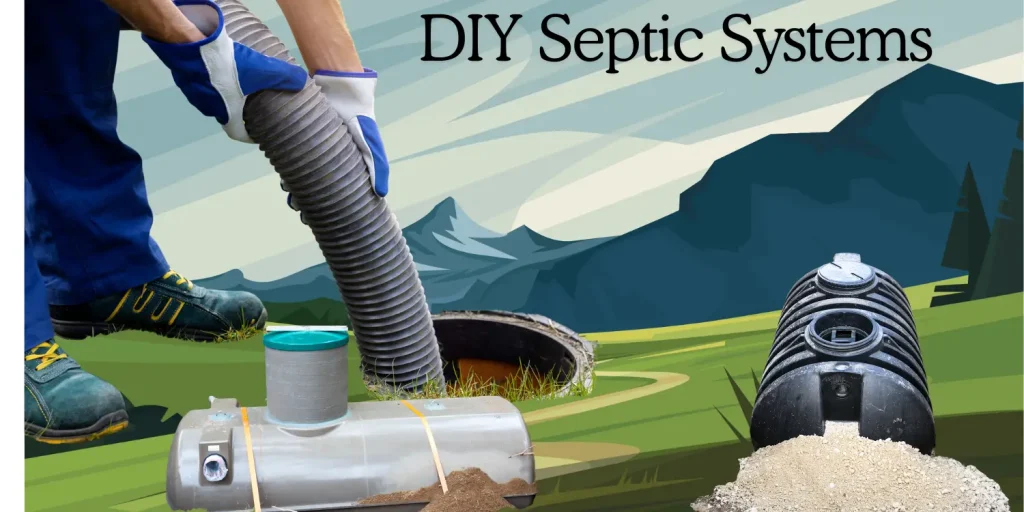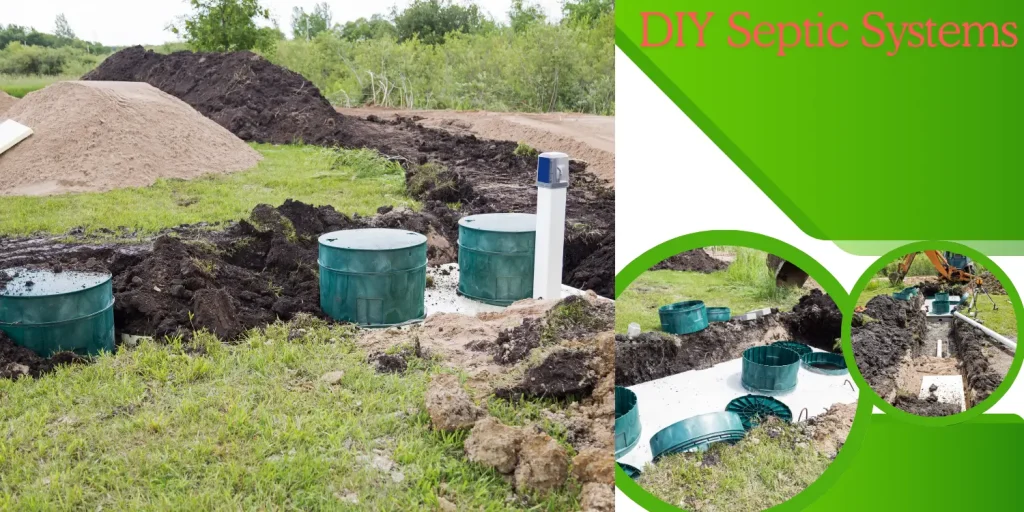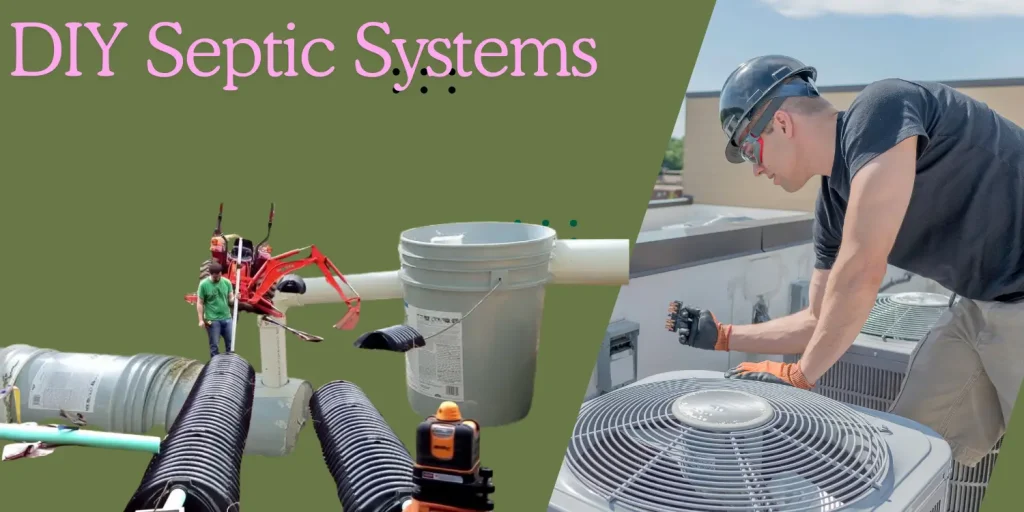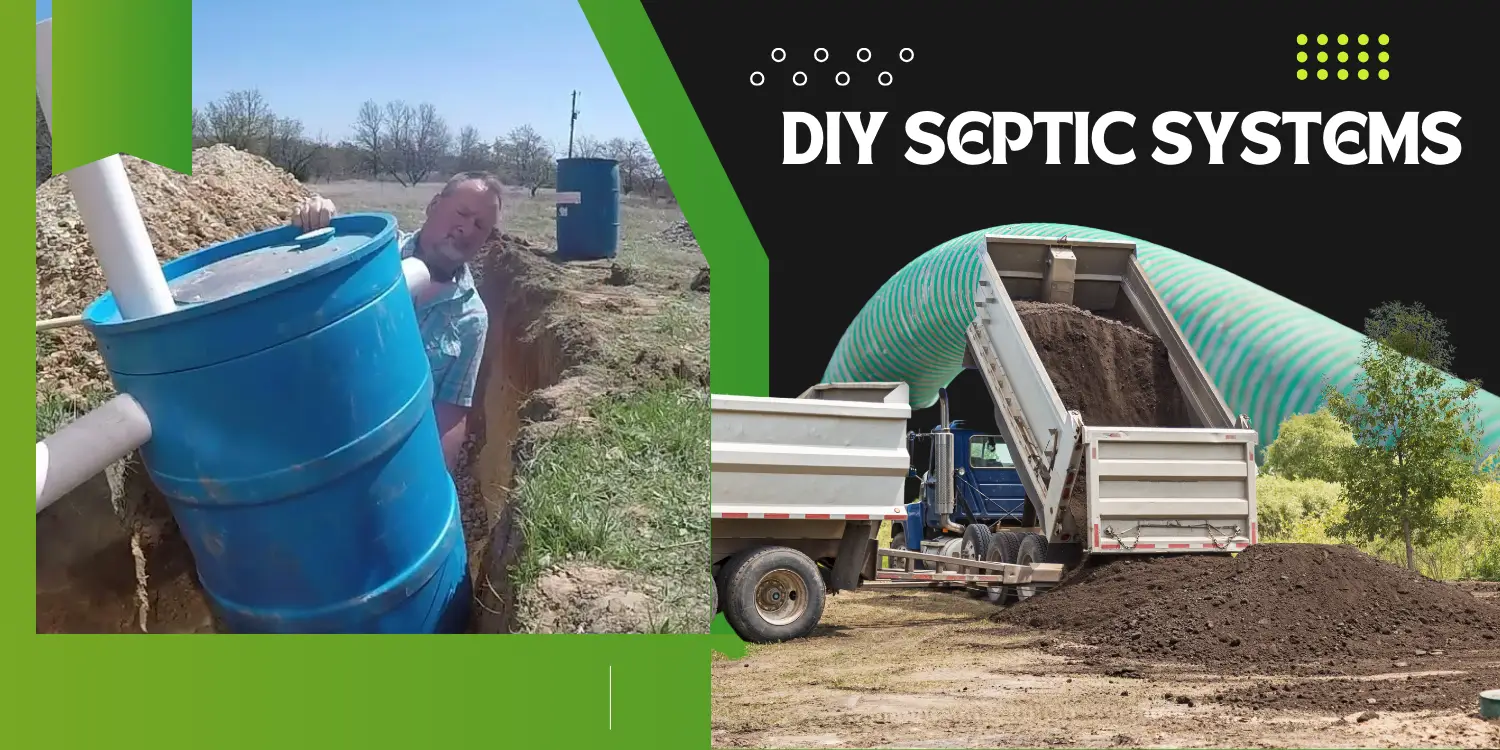Introduction to DIY Septic Systems
In this case, for residential units placed in the countryside or areas that lack municipality sewerage systems, a septic system is crucial for disposal. These systems are designed to efficiently as well as socially responsibly deal with wastewater from households. Although getting a professional contractor to do the work is recommended, most homeowners opt for DIY to reduce costs and have full freedom on the design and the manner of installation. Consequently, a do-it-yourself septic system is a viable and cost-effective project when appropriately executed.
One of the advantages of DIY septic systems is low labor, and another advantage is the ability to adapt the system according to site conditions. In essence, to ensure that the system runs safely and it meets standard environmental requirements, the process requires planning, legal understanding of the country where the project is based, and technical knowledge. The different major components of a septic system are a septic tank, a drain field (or leach field), and pipelines that transport wastewater. Because trash accumulation and contamination of areas or groundwater nearby need to be regulated, meticulous selection and installation of each component are necessary.
Self-constructing a septic system is a tremendous deal of work, as you have seen. If the installation is done poorly, then it will also lead to costly corrective works, damage to the natural surroundings, and may even breach the law. Therefore, one must familiarise themselves with the construction guidelines in a specific area, obtain the required permits, and assess the type of ground in the area before initiating the project. It is also incumbent upon homeowners to select the correct system type from the mound system, aerobic system, as well as the standard gravity system.
Thus, this book will discuss the essential procedures, equipment, and considerations to be observed while planning and installing a do-it-yourself septic system and equip the homeowners with adequate skills and confidence to accomplish this task safely and efficiently.

What is a DIY septic system used for?
On this page, homeowners discover how they can deal with household sewage and wastewater by creating a DIY septic system, an on-site wastewater treatment system. It is often used where access to the public sewer systems is either not available or provides a high construction cost for a sewer system. For people who know how to build one on their own and those that are in a financial capacity to do so, then these systems are often cheaper than the professionally installed septic systems.
A DIY septic system treats and disposes of wastewater from the home sinks, showers, toilets, baths, and other drainage sources safely.
Usually it comprises a septic tank in which solids settle at the base and a drain field, or a leach field, which allows the soil to soak and filter the liquid effluent. A Septic Systems is useful in managing home waste by removing contaminants by treatment on the same site it is located, thus avoiding polluting nearby water sources.
Septic systems for cottages, small houses, RVs, or places with poor access demand DIY solutions most of the time. As they offer more autonomy and may be tailored to the specific site characteristics, they are most appealing to people who are interested in sustainable or even tiny homes.
Nevertheless, constructing a do-it-yourself septic system is possible, but it requires much planning, research on local regulation, and understanding of soil type, water flow, and the right construction materials. Some of the issues associated with inadequate planning or design and implementation of the systems include legal issues, health risks, and environmental risks. It is therefore important to undertake a search of the local building codes, to acquire the relevant licenses, and as well seek professional help when needed.
All in all, the ‘DIY septic system is an effective and accessible means of tackling domestic wastewater where big centralised sewer systems are out of the picture. It is a secure and cost-effective waste management and disposal technique, given that it is well constructed and managed.

How Does a DIY Septic System Work?
One on-site treatment solution for buildings outside the municipal sewered areas is a DIY septic system. It also physically treats and disposes of waste from sewage from sinks, toilets, and other drainage systems in the home. This is how it operates:
1. Collection of wastewater
Your home’s wastewater goes to the septic tank, that being the first part of the system. Made mostly of fibreglass, plastic, or concrete, this particular type of tank is installed, and most of it is buried. It acts more as a settling tank wherein liquids and solids are separated from each other.
- By consciousness of the nature of life, dissociation and disintegration shall be understood.
Fats, oils, and greases literally float, forming a scum layer on the top of the septic tank, while solids precipitate at the base, forming the sludge layer. Organic matter is decomposed within the intermediate liquid layer or the effluent layer of bacteria. With time the traces of solids reduce because of this natural decomposition.
3. The discharge of effluent
The partly treated wastewater that leaves the septic tank goes to a leach field or drain field. This area is formed by the system of perforated pipes that are located in the ditches filled with gravel. When the water runs through the surface downwards, the gravel and soil act as filters, filtering out any pollutants and anything of that nature.
4. The tremendous load and the absorption of soil as well as the last steps.
By chemical and biological activity, the soil in the drain field also helps to cleanse the wastewater. Beneficial microbes in the soil eliminate a number of dangerous germs and nutrients to allow clean water to replenish the groundwater system.
DIY Things to Think About
Constructing your own septic system can be a simple process, though it requires proper designing, procuring the right supplies, and also going against the local laws. Proper and durable septic tanks, planned drain fields, and excellent quality pipes are some key components of it. Check the right sizing, conduct the right soil suitability tests, and have the right licenses from the relevant local authorities.
Long-term functionality and low likelihood of system failure can be achieved by maintenance, and each of the tanks should be pumped every three to five years.

How do you make a homemade DIY septic system?
Building one’s own septic system can be practical for short-term or emergency use or for living in an unpaved area. This is important in order to avoid legal issues or worsen an environment; that is why the system should not violate the law. The following is a general guide on installing a simple septic system:
### **Required Materials**
Polypropylene septic tanks or drums (55 gallons)
Sand and gravels; PVC pipes (inlet and exit)
Perforated PVC drain field pipes; pick or any tool required to dig the ground
Filter cloth; PVC adhesive or cement; Drill, preferably with a hole saw.
—
#### **Septic System DIY Installation Guide**
#### **1. Select a Site**
As a form of sun power, select a site that is lower than your home so as to benefit from gravity. If possible, it should be situated not less than 50-100 feet away from water sources like lakes, streams, wells, etc.
#### **2. Dig the hole for the septic tank such that the tank will fit in the hole well.
Do the work by digging a hole that will adequately accommodate the septic tank or 55-gallon drum. It should be possible to link the home’s plumbing system intake pipe to the tank if it is deep enough.
#### **3. Get the Tank Ready**
For the inlet and outlet pipes, drill holes that are near the top of the drum. When joining these pieces with PVC pipes, make sure you use cement or PVC adhesive to ensure faster coverage and a tight joint. To ensure that there is enough flow, the intake pipe should be such that it enters at a higher point than the output pipe.
#### **4. Drain Field Installation**
For the drain field, excavate trenches around the tank two to four feet deep and hidden away from the tank. The bottom layer should be filled with gravel, and the next layer—with perforated drain pipes. In order to prevent the soil from penetrating the pipes, place extra gravel on top of them, followed by filter fabric.
#### **5. Sewer—step 7: Connect the Drain Field to the Tank
Next, screw the effluent outlet pipe into the septic drain field system. In order to facilitate drainage, the pipe should follow a downward incline.
#### **6. Cover and Backfill**
Bury trenches and tanks, as any metal work is conspicuous. It should offer an entrance for the tank upkeep, be it washing or the pump kind.
—
### **Upkeep Advice**
To prevent this, you should regularly come and check the tank as well as pump the tank if it is full.
Do not apply water to chemicals or other non-degradable items that are capable of suppressing the bacterial function.
#### **Some Important Notes**
Not all situations require the implementation of a DIY septic system; it may not even be legal to the environment or architectural standards. However, to maintain safety and legal issues, always consult professional and local authorities when carrying out this practice.

What can I use instead of a septic system?
Below, depending on your geographical location, budget, and concerns about the environment, there are a number of options if you are looking for septic system alternatives. Each system is designed to handle wastewater in the most effective way while offering solutions that are special to the needs of the system. Here are a few suitable substitutes:
1. ATUs, or aerobic treatment units:
The structural complexity of ATUs is similar to the simplest sewage treatment plants. These are relatively new compared to conventional septic systems and use oxygen to decompose the waste, thus producing cleaner water aeration effluent that is useful for irrigation or letting into the surface.
- Composting Toilets: Lovely for branded or austere houses, ghastly latrines do not require water and turn human uses into safe and vital humus. Despite the fact that these systems are cheap and conserve the environment, they have to be serviced regularly.
3. Constructed Wetlands: Such a wastewater treatment technology emulates wetlands. The water that is produced is therefore filtered and cleansed by microbes and plants before being safely discharged. Constructed wetlands provide numerous ecological values, and at the same time they are beautiful landscapes.
4. Mound Systems: Housing structures that are well-adapted by mound systems are those that experience poor soil drainage. Wastewater is predominantly treated on a filter stand, constructed on a mound of gravel and sand on which the water flows before it returns to the environment.
5. Drip irrigation systems: These systems integrate pro-waste management and landscape irrigation, where the wastewater is treated and repumped directly to the root areas of plants through underground pipelines.
6. Holding Tanks: These tanks store wastewater until they are pumped out and transported to treatment facilities—great for homes that don’t use much water.
Positives and negatives come with all Sig options. To make the right decision about the property and to act accordingly to the laws of the specific area, I would suggest you contact an expert.

Can I use a water tank as a septic tank?
While it is technically a possibility, it is very unwise to use a water tank as a septic tank due to certain practical, safety, and legal considerations. Bacterial processes of decomposition of the consortium of organic substances are made possible through a septic tank, which is specially designed to contain and treat sewage by decantation. Structural and functional requirements for wastewater treatment are not present in water tanks that are designed for storage of fresh water.
Essential Differences between Septic and Water Tanks
1. Construction and materials
These materials include, but are not limited to, concrete, fibreglass, or other forms of heavy-duty plastic because sewage and other gases, such as hydrogen sulphide and methane, are well known for their corrosive qualities. Since water tanks cannot be as long-lasting, or even corrosion resistant, as septic tanks, they are unsuitable for long-term use.
2. Features of the Design
In order to distinguish particles, scum, effluent, and septic tanks are equipped with baffles, compartments, and pipelines for inlet and outlet. Water tanks cannot be used to treat wastewater because these structures do not possess these interior components. Their failure may lead to blocks staining or polluting the surrounding environment due to poor handling.
3. Ventilation Septic tanks have been installed with ventilation that will allow the gases that are produced while decomposition to be released safely. Since water tanks normally do not allow circulation of air, the same facility can be dangerous for housing sewage due to dangerous build-up of pressure or leaks.
4. Adherence to Regulations
In most countries, septic tank design and installation are accompanied by a number of limitations and restrictions. These rules may be violated by choosing an unapproved water tank that may have legal as well as environmental consequences.
5. Safety and health.
Leakage from untreated sewage that might have been resident in a water tank that was reverted inappropriately could pollute the water table and in the process pose health risks to humans and animals. Sewage contains dangerous chemicals as well as pathogens, and therefore, proper containment and treatment are required.
Other Considerations to Look at
You might want to look into modular systems designed for a specific use or a series of prefabricated septic tanks that are composed of lightweight plastic if you need a septic system but do not have the capital for a traditional septic tank. These are safer choices that meet environmental requirements.

Features of a DIY Septic System
In areas that are not served by a municipal sewage system, a DIY septic system is a form of installing septic systems at home independently. These systems are designed to be cost-effective and specific in regard to specific properties. For these to be functional and safe from a point of view of environmental impacts, it has to be well planned and meet all the set legal requirements. The main components of a do-it-yourself septic system are as follows:
1. The septic tank
The key component of the system, the septic tank, is designed to store and decompose the wastewater. This equipment that separates solids from liquids is often made of plastic, fibreglass, or concrete material. Coarser elements and substances of low density form skim, while fatty and greasy substances and others with high density aggregate at the base to form sludge. Then the drain field is where the liquid effluent goes for further treatment.
- Leach Field, or Drain Field
The cleaned wastewater is discharged to the surrounding soil through the use of the drain field. It is composed of chambers or perforated pipeworks that are installed in trenches containing gravel. Before the water manages to get back to the groundwater system, the soil acts as a filter that removes most nutrients and deadly bacteria. As a result of its vital role, the drain field must also be correctly located and designed in order to prevent pollution and the failure of the overall system.
3. Chambers, or perforated pipes
The liquid reaches every part of the drain field by using prefabricated chambers or perforated pipes in the process. These are elements that help make the maximum absorption and filtration through the soil possible. Proper installation ensures consistent water flow along with a low likelihood of water system overload.
4. Opening to Permit Further Point of Inspection and Air Intake
Since gas manufacture is part of the septic tank sludge decomposition process, use of venting pipes is inevitable. Maintenance and inspection ports provide homeowners with the ability to gaze into the levels of sludge and scum to experience system efficiency.
5. One of the famous business strategies that has been overemphasised in the current globalisation is flexibility and cost leadership.
DIY septic systems are usually preferred due to their low cost. Owners can change or add to the design of the system based on certain property needs and can use very available resources. And because of this flexibility, it is on the list of preferences for off-grid and countryside dwellings.
6. Adherence to regional laws
DIY systems have to comply with regional environmental and health standards. These rules often include such items as the size and design of tanks, soil permeability tests, and minimum dimensions of distance that must be maintained between the tanks and water sources. Sanctions and system failure are possible consequences of noncompliance.
7. Requirements for maintenance
One of the most important factors that can help a do-it-yourself septic system to last even longer is maintenance. These include part checks, compartment pumping, and no obstruction. Lack of proper system maintenance can create problems; he further explained they may lead to costly repairs and environmental hazards.
Therefore, a DIY septic system is a combination of the best price, the best of both worlds, and usefulness. But very careful planning, proper installation, and constant exercise are required for an ideal implementation.

Conclusion
It appears that constructing an individual DIY septic system is an effective, cheap, and practical solution for off-grid and rural areas. To create a durable, effective, and environmentally friendly system, one should think twice while choosing an appropriate option and obviously have to comply with the legislation of the given area. Each one requires more careful work to stay focused and use only the environmentally friendly approaches, whether it is the construction of the standard conventional system with septic tank and drain field or looking at the new innovations such as composting toilets.
Before doing this job, you need to understand the characteristics of your site: the type of soil, the water table levels, and the slope. These aspects influence the construction and operational nature of your septic systems. If the tank is too small or if the drain field is too limited, then further ills can ensue; thus the tank and drain field must be of a size to accommodate the family’s use. It is easier to maintain durable materials; hence, to ensure its longevity, we should choose durable material that can last for many years.
Do it yourself. septic techniques require routine maintenance. These are things like checking the system frequently, pumping the tank when needed, and ensuring that the drain field is open. Disregard for the maintenance process leads to costly repairs, pollution of the environment, and increased health hazards.
Again, this is a legal requirement and a must to ensure that you avoid running into legal complications; also, as we all know, to ensure that your system is running safely and effectively. If in doubt, consult with experts or regional health offices; such a decision could save you time and money.
If you want to attain a dependable and sustainable wastewater treatment, there is a way to do it yourself; you just need to invest some time in selecting, constructing, and maintaining your septic unit. Besides the economic aspect, it illustrates commitment to more responsible lifestyles and enhanced functionality of a building. If you take some of your precious time and energy to make it, you will surely have a system that will continually fulfil your household needs as well as protect the environment in the future.
